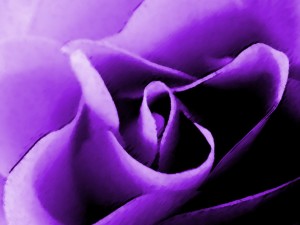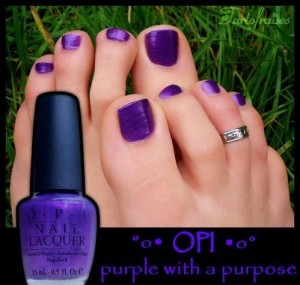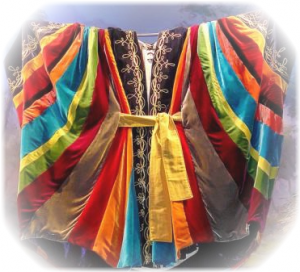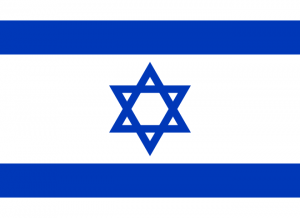Purple With A Purpose
I love the color purple (not so much the movie The Color Purple, although I’m a huge fan of Whoopie and Oprah), but I mean the hue as in periwinkle, lavender, magenta, violet, indigo.
Whenever I wear OPI “Purple With a Purpose†on my toes, I feel creative, glam, and fun.
Turns out the color purple is symbolic in both Jewish and non-Jewish cultures. The Israelites, for example, used an indigo-colored dye called tekhelet, which comes from the mucus of an ancient small sea snail murex trunculus. This dye, known as Tyrian purple, was used by royalty and the upper-class in dyeing their clothing, sheets, curtains, and such. Maybe I’m attracted to everything purple because I was a king or queen in a past life, who knows.  Purple is also the color of the purification from sin, and God only knows I carry a lot of guilt.
The Torah mentions purple, as well as these other colors:
BLUE, for instance, is the color of sea and sky. This calming color also represents height and depth, and even equilibrium because it suggests a shade midway between white and black, night and day. Furthermore, the Torah instructs Israelites to put fringes, or tzitzit, on the corners of their Jewish prayer shawls as a reminder of God. The Flag of Israel has two blue stripes and a blue Star of David against a white background. In modern Hebrew, blue-white is used as a synonym for Israeli, an adjective, to distinguish local produce from imported goods.Â
Also, blue is also associated with the ten commandments. When Moses and the elders went up the mount Sinai, they saw God standing on a sapphire pavement and the tables of the law were made of the stone as a permanent reminder of the law of God.
WHITE, symbolizes intellectual purity and innocence as the true color of light without any alteration. Never mind that fashionistas tell us not wear it after Labor Day. Notice the color of the Rabbi’s robe on the high holidays—white!
White is often associated with being pure, clean, fresh and good. The color of a fresh snowstorm brings up images of a peaceful and pure winter scene. White usually is associated with being almost heavenly.
GOLD, among other precious metals, is symbolic in Judaism. It stands for the Divine or celestial light, much like blue. Silver is the emblem of moral innocence and of holiness. Brass symbolizes hardness, strength, and firmness.
RED, as in scarlet and crimson, symbolizes blood or life itself, as well as joy and happiness. Crimson is a strong, bright, deep red color. It’s originally the color of the dye produced from a scale insect, Kermes vermilio, but the name is now also used as a generic term for those slightly bluish-red colors that are between red and rose including carmine, raspberry, ruddy, ruby, and amaranth.
To me, purple is the new black.
For a detailed explanation of the significance of color in the Jewish religion, look here.Â
What’s your favorite color?
On another note, here’s behind the scenes of the colored coat in Joseph and The Amazing Technicolor Dreamcoat.
And here’s an encore to one of my favorite shows of all time!




